All businesses are challenging, but seasonal businesses present a plethora of unique challenges, including budgeting, hiring seasonal labor, and managing cash flow.
Another unique challenge that we growth folks know all too well is how seasonality makes paid search particularly difficult.
As Adam Greenspan, VP of marketing at Everfest, says, “The whole industry is riding that wave, so from a paid search perspective, there’s definitely an increase in competition - not to mention all metrics can swing wildly.It’s a little nerve-wracking trying to catch that wave on the upswing each year, but it’s what you’ve got to do to hit the season hard.”
However, when executed properly, seasonality can present an excellent opportunity for your business to beat your competition and thrive.
In this guide, I will detail the learning, planning and execution steps required to crush your goals despite the unpredictable nature of seasonal businesses.
Section 1 - Qualitative Learning
Qualitative learning is a key aspect for nearly every channel or niche of marketing, and Adwords is no different.
Plenty has already been written about gathering qualitative feedback, so no need to rehash that here. Instead, we will focus on getting a picture of your business through a few questions you might want to answer. Included are examples of real companies and how they can leverage these qualitative insights.
What causes people to shop in your targeted season?
It is important to get into your buyers head to understand what is causing them to buy during this season. In some cases–such as Black Friday or other holidays–it is easy.In others, it might be a little more nuanced.
For example, self-storage is a highly seasonal business, as indicated by the chart from Sparefoot below.
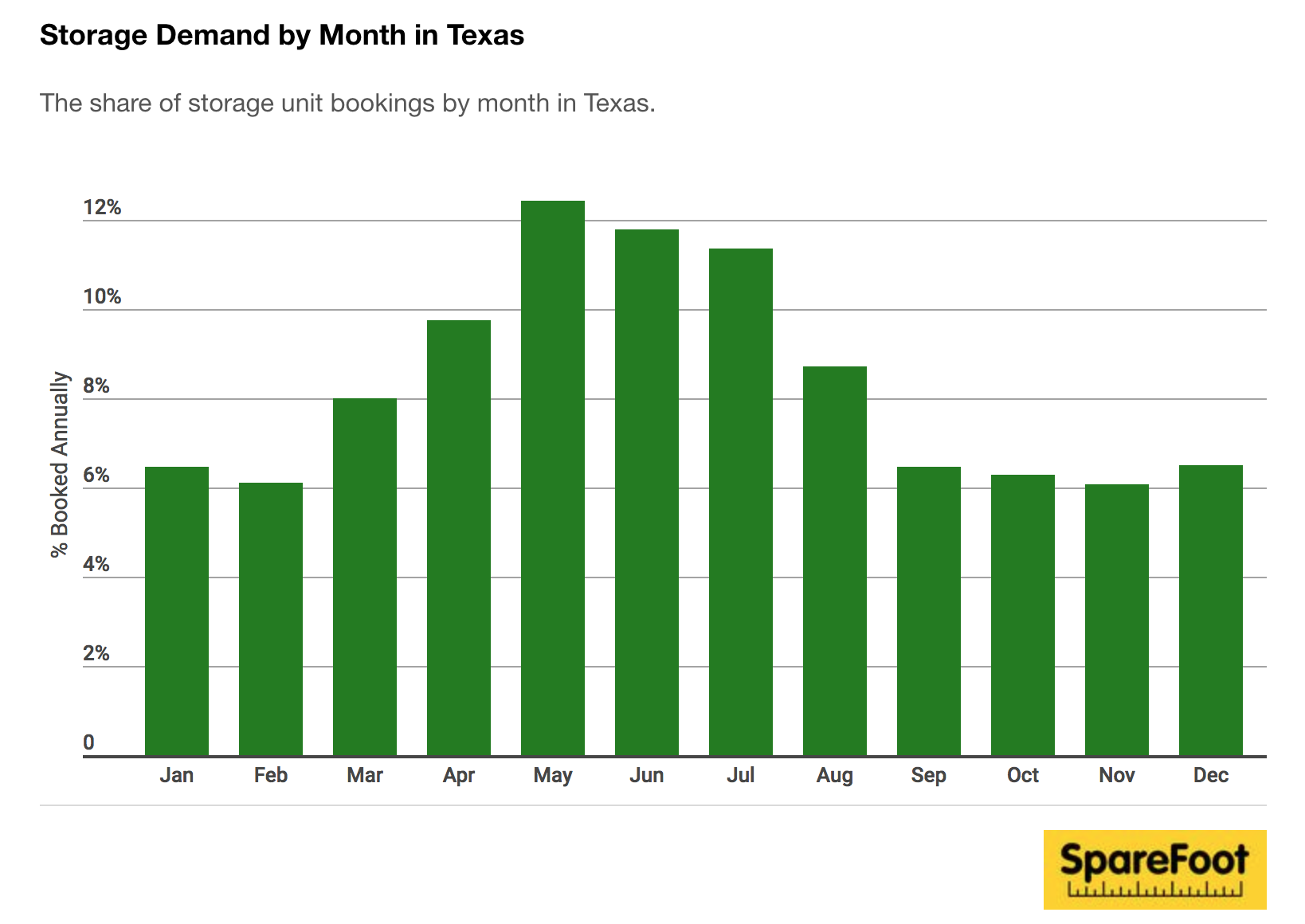
Image Source: Sparefoot
As it turns out, self-storage is seasonal for two reasons. The first reason is that it is moving season in general.And the second reason is that college students need a place to store their stuff over summer when they get kicked out of their dorms. Sparefoot capitalizes on this by creating unique ads and landing pages for major universities.
Some of these insights might be common sense, while others maybe not so much. It is important to talk to your customers to figure it out.
One entrepreneur and marketer lives in an industry you wouldn’t necessarily think of as seasonal: virtual reality rental.
William Griggs is the founder of VirtualRealityRental.co.He says, “In the summer event professionals look for cooler climates to host their events. Sorry, Texas. On the flipside, in the winter event professionals look for warmer climates to host their events. These factors were identified through both customer surveys and attending industry events (plus, a healthy dose of common sense).”
What is the buying process like for customers?
Most marketers are familiar with the concept of a purchasing funnel or buyer journey.

Image Source: McKinsey
However, since those of us in paid search tend to live and breathe at the bottom of the funnel, we often forget that consumers rarely wake up and buy something.
While conversion funnels like these are conceptual and rarely this linear, there can be an opportunity to understanding what a consumer does in the days, weeks or months before they decide to purchase from you.
The best way to understand your buying cycle is to have a conversation with your customers.Ask questions along the lines of the following:
When did you first decide you needed [product]?
What caused you to purchase [product] when you did?
What would have made you buy sooner?
What research, if any, did you do before you bought?
At my company, LawnStarter, we learned very early on that customers often purchased yard cleanups during late winter and often hired the same person to mow their lawn when the weather warmed up. In turn, we started bidding on keywords such as ‘spring cleanup + [location]’’ and ‘leaf cleanup + [location]’, knowing that if we just broke even on the cleanups, we would likely earn repeat business a few months down the line.
Do different words mean different things throughout the year?
Anybody who has been around the block in the search game knows how frustrating words with multiple meanings can be.
In seasonal businesses, the same word can have a different meaning depending on the season.
For example, the term ‘lawn care’ is a broad term that refers to all services related to the lawn.However, most people who use the word lawn care in Spring and Summer mean ‘mowing the lawn’, whereas in Fall they mean ‘lawn fertilization’ and winter they mean ‘lawn cleanup’.
How did we learn this?A combination of Livechat records and on-page polls.
If some of your high volume keywords happen to have different meanings, you might want to test ad or landing page copy that highlights the various meanings (assuming you offer products related to all meanings).
What activities do people do during the off-season?
The off-season can present a big opportunity for seasonal businesses.
Talk to customers who purchased during the peak of the season, and ask what they were doing during the off-season. Then talk to customers who purchased during the off-season. This should give you some ideas.
Also, pay close attention to your competitors and similar businesses during the off-season–you might learn something interesting. For example, the demand for job-related searches peaks in January, but according to executive recruiter Josiah Whitman,“Hiring managers and bank CEOs will typically try to reduce their operating profits by incurring search fees towards the end of each year, to avoid paying taxes.”
If you are running a recruiting agency, this might be the perfect time to up your bids since the giants–Linkedin, Monster, and Indeed–likely allocate much of their budget to January, but meanwhile, you have a higher placement rate in December.
Section 2 - Quantitative Learning
Now that you have a base qualitative understanding of your industry, it’s time to dig into the numbers. Here are a few questions that will help you gather the quantitative data in preparation for your busy season.
When does your season start and end?
If you have been in business a few years, this part is easy–simply look at when impressions ramped from previous seasons. If you don’t have a full cycle’s worth of data, you can generally get a good idea of your seasonality from Google trends.
If the weather is the cause of your seasonality, you will likely have different start and end points depending on the geography. See the differences in search volume via Google trends of lawn care between Pennsylvania and Florida below.
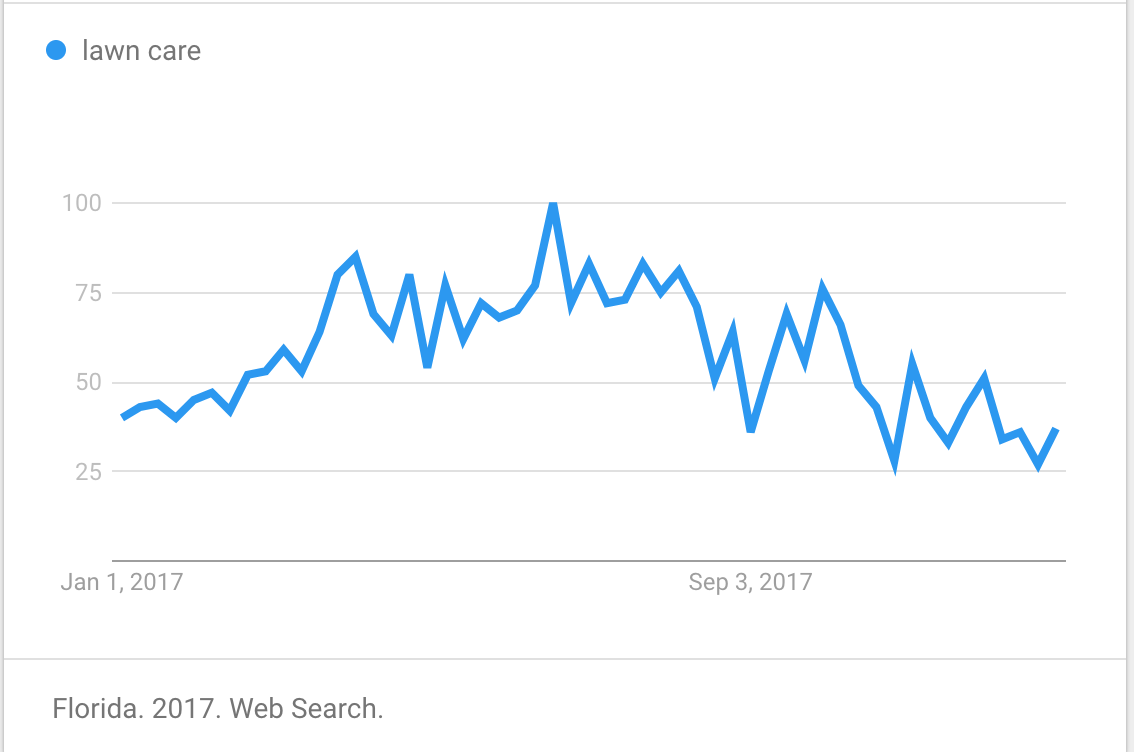
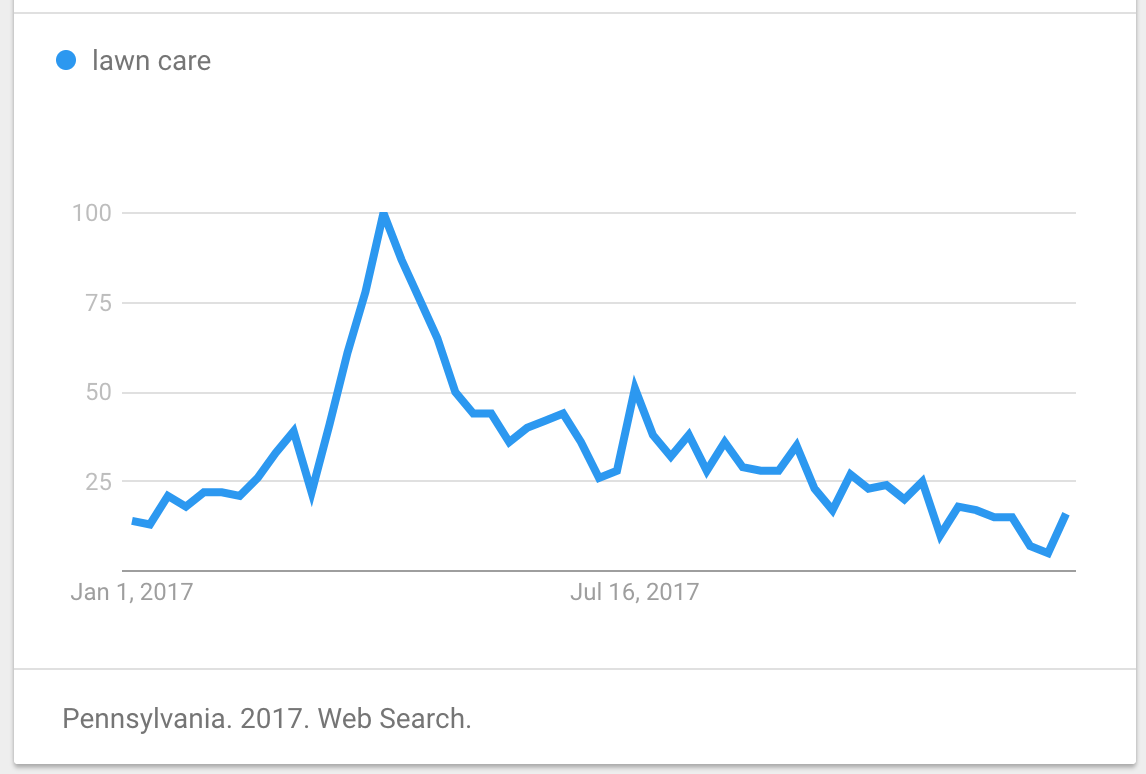
Image Source: Google Trends
Another interesting way to learn about your industry’s seasonality is via public company filings. Henry Shi, co-founder of Snap Travel - a way to book hotels via Messenger or text - says “We’ve learned a lot about seasonality trends by looking at annual reports from public companies like Expedia and Priceline.”
How do conversion rates differ over time?
“One thing we learned from the public filings, and that we soon saw in our data, is how wildly different conversion rates were by season”, says Shi.
Seasonal businesses almost always have different conversion rates depending on the time of year. If more people are searching for a product, they probably have more search intent.
However, you should not assume this is the case. You should look at the data. To get a quick view, you can simply plot ‘conversions’ and ‘impressions’ as seen below.

Image Source: Google Adwords
However, averages can often lie. So, it is important to go into your AdWords reports and look at conversion rate by keyword, ad groups, and campaigns.This will ensure segment is not skewing everything.
How does competition factor into all of this?
In a seasonal business, competition will increase during the busy season–that is almost guaranteed.
To forecast costs and revenue properly, you must account for the increased competition. Increased competition will increase the price you need to pay in order to get clicks. The amount you should bid is defined by your conversion rate, the lifetime value of your customers, and your desired ROI. So in general, your max CPC should be fixed.
Now, you can use the Adwords forecast tool to get projections of clicks, conversions, and costs.
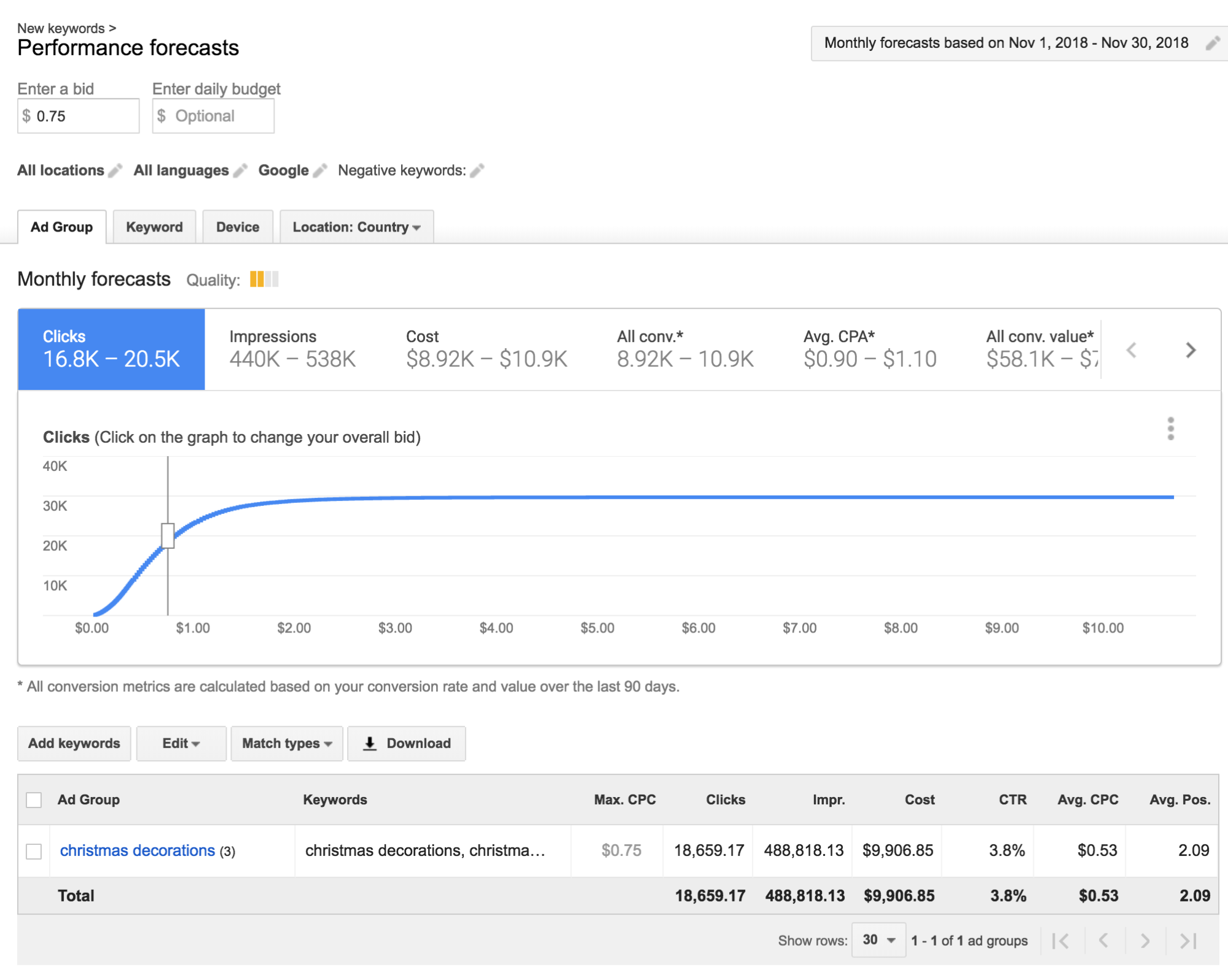
Image Source: Google Adwords
As you can see in the chart below, the same $0.75 cent bid for terms related to Christmas will result in a significant loss in CTR between July and November.
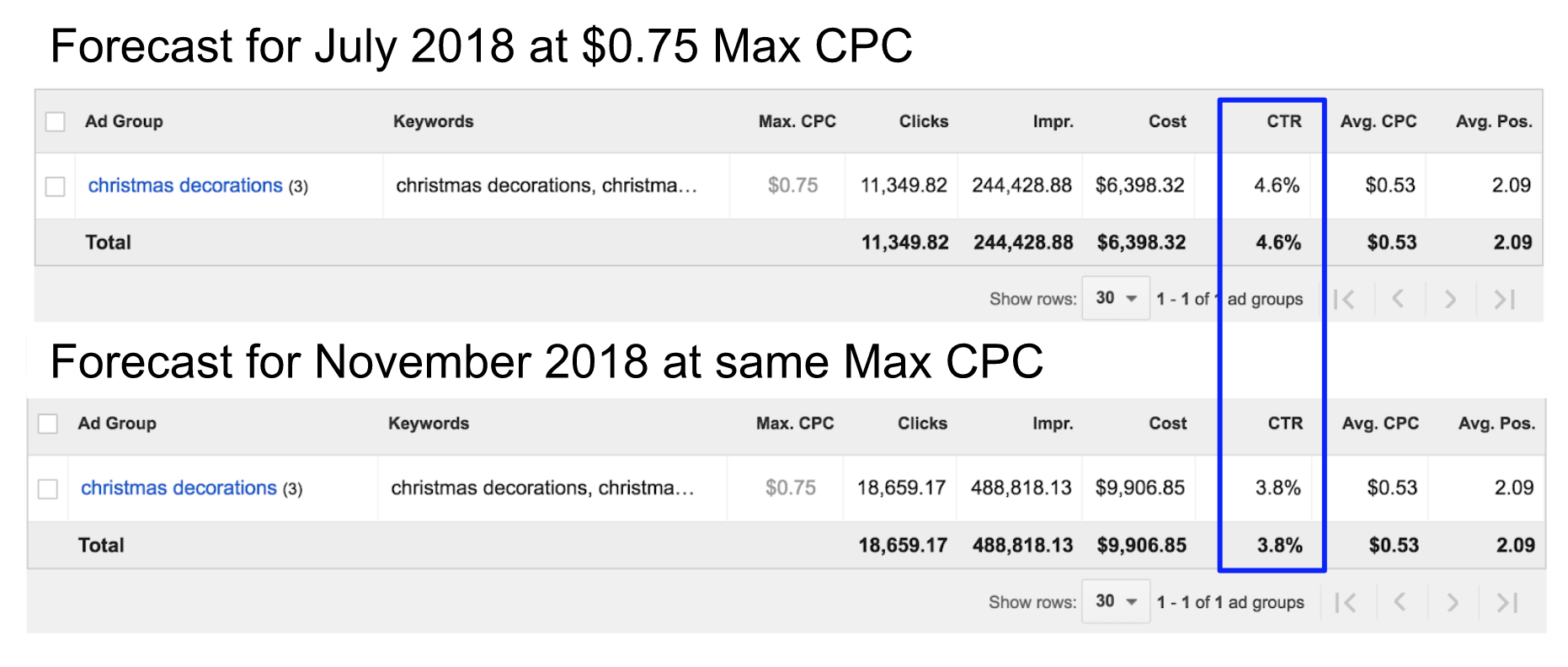
Image Source: Google Adwords
Keep in mind, this tool uses your prior 90-day conversion rate to forecast. If you had previously determined that your conversion rate differs over time, you should download the click into Excel and apply conversion rates manually. More on forecasting paid search here.
Additionally, you should NEVER trust Google’s tools out of the box. Far too many case studies have shown Google’s tools to be misleading. That being said, it may be the best you can get. So when possible, compare with your own data to get a better understanding.
Are there retention and repeat purchase differences by season?
Seasonal businesses often have to account for the fact that customers will have different lifetime values by season.
A simple example is Black Friday and Cyber Monday. Every searcher during this time is expecting a discount. If you are offering discounted products, the conversions are worthless to you.
Let’s take a more nuanced example, such as RV travel. Ravi Parik is the founder and CEO of Roverpass, a booking site for RV travel. He says, “Though winter tends to be slow for us, those cohorts show two to three times the repeat purchase rate, and are worth significantly more. This is because if you’re booking RV travel in the wintertime, you’re probably an enthusiast and own your own RV. Whereas in the summer, you see more casual travelers that only go on an RV Trip once every few years.”
If you are an e-commerce company or something very transactional, you might be able to use Google Analytics to figure this out. CXL has a great guide on this sort of tracking.
Now, if your business is a bit more complex, you will likely need to make sure your subscription data is linked together with the initial conversion, and plot retention your cumulative LTV curves on a chart by cohort, as seen below.Here are retention and cumulative LTV curves for a fictitious dog-boarding company.
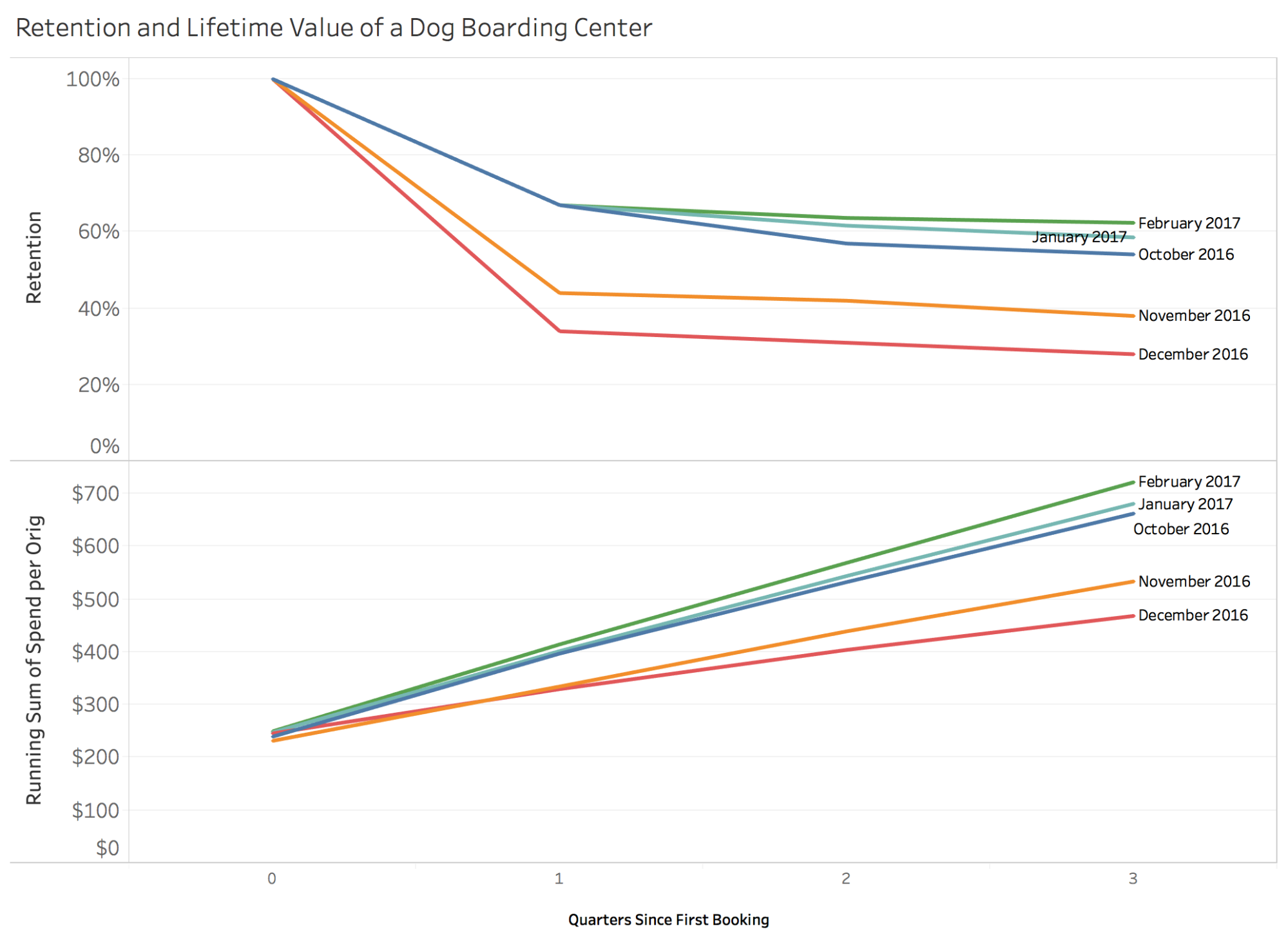
Holidays are the busiest times of year for dog boarding companies as many people need their dogs watched over the holidays. However, many of these people are not regular dog boarders, hence the drop-off in retention in November and December. This drop-off in retention results in 25% lower lifetime values (at the 1-year mark at least). If this pet center is bidding on Adwords, they better drop their bids accordingly.
Section 3 - Planning and Execution
Anybody who has managed a seasonal business knows how crazy the busy season can get.
Just ask Josh Braaten, CEO of Brandish Insights, who has a long background in managing paid search for the for-profit education space.He says, “Search demand ebbs and flows week-to-week throughout the year, and if you miss a pocket, you can either significantly under-deliver or overspend.”
During the season, you can expect to have your hands full reacting to the swings, so planning is key.
When should you start planning?
“Ideally, forecasting and budgeting should all be started at least six weeks before the busy season” according to Braaten.
While the amount of time may vary by industry, it is important to give yourself a lot of time to prepare.
To decide how much time you need, start by laying out all tasks that must be done, and estimate each. I am a fan of a lightweight version of Scrum for this part. You should assume that you have no spare time during the season, other than managing your campaign. Give yourself a 20-30% buffer (things never go as planned), and back out your start date. Ideally, you have a week lull where you can relax before things get crazy.
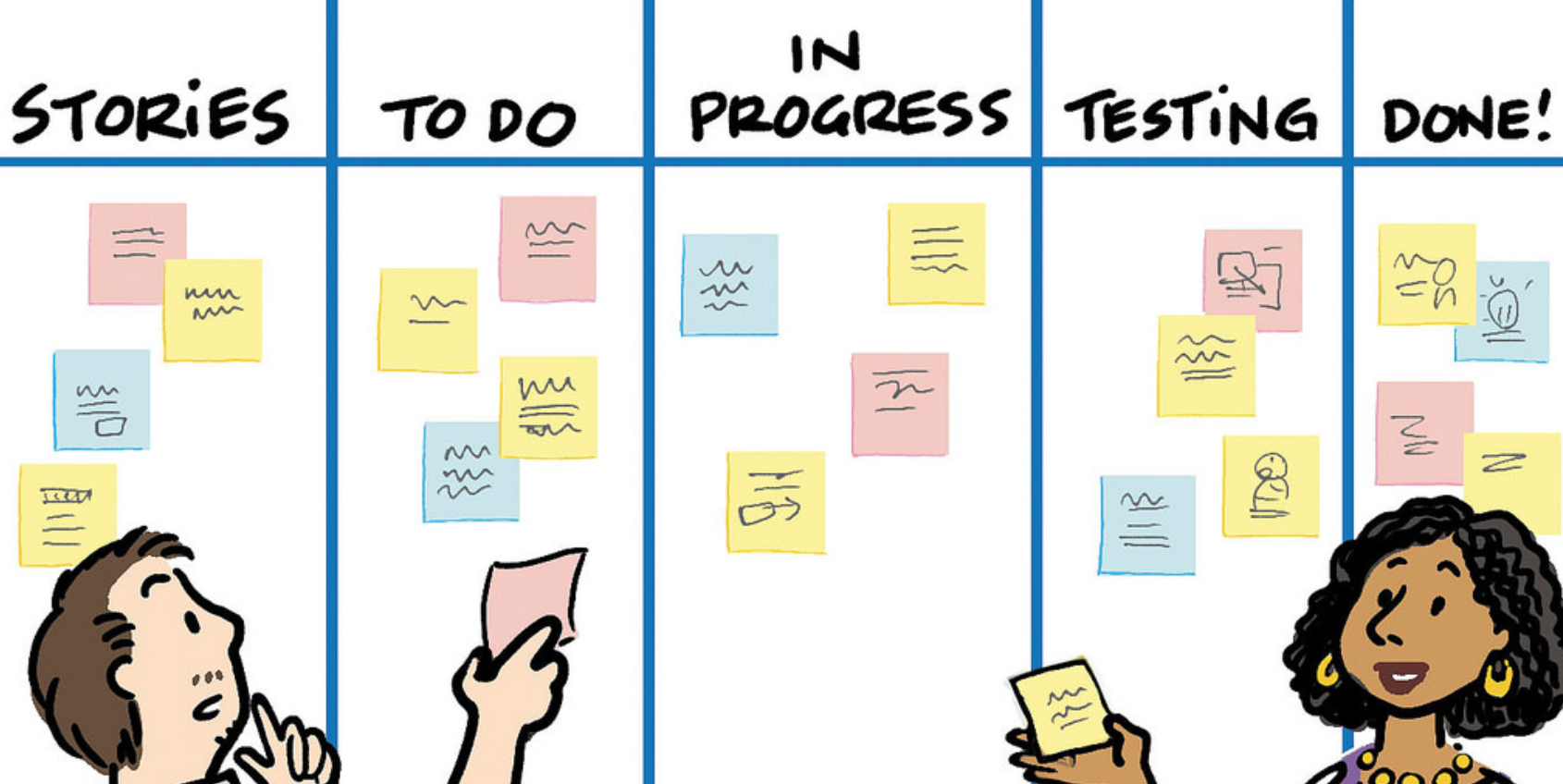
Image source: Flickr
What You Should Plan Ahead of Time
For starters, you should make sure all systems and tracking are working properly.Something as simple as a misplaced conversion pixel could ruin your entire season.
Secondly, make sure all of your campaigns are not only set up properly but in a way that is easy to monitor and make changes. Ad labels are your friend here.
Plan what ad copy, landing page, or targeting tests you would like to run ahead of time. You won’t have time to ideate, learn, and implement during the heat of things. Set things up in a manner that you can call and implement the winner easily, then move onto the next test.
Finally, it is important to plan for several different scenarios. Non-seasonal businesses can simply look at the trailing time period and adjust when they are off the mark. Seasonal businesses need to be ready to pivot in a moment’s notice.
As Josh Braaten says, “multiple budget scenarios should all be modeled and drilled so that teams will know how to quickly shift budgets across campaigns, mediums, and keywords depending on what's converting during the rush.”
Setting Up a Monitoring Plan
All of your reporting should be set up ahead of time if you don’t have them already.
How often are you going to check conversion rates? What campaigns, ad groups, labels, or keywords will you adjust bids on? How close or far are you towards your goals? How do we know that something isn’t broken? Is this A/B test winning or losing, and has it reached sufficient sample?
A monitoring plan helps you pay attention to the metrics that matter, helps you know how metrics are trending relative to forecasts, and helps you correct course if and when things deviate.
During the Busy Season
The busy season is not the time to come up with new ideas, try brand new channels, or talk to customers.
It is time to focus exclusively on executing your plan.
“It’s a lot like putting on a big conference”, says Alex Birkett, Growth Marketing Manager at HubSpot. “When we were putting on CXL Live, months of planning, testing marketing, and sales goes on beforehand.But as soon as people show up to that conference, you need to execute the plan, put out fires, and react to things in real-time”.
What does this look like in practice?
Here at LawnStarter, we have a weekly metrics review, where each team member presents his or her metrics. During the busy season, this meeting requires more granularity than usual, and each team member is encouraged to scrutinize metrics for anomalies that others may have missed. All of what is presented was laid out in our monitoring plan.
Any questions to be answered or action items are turned into tasks and put in a Trello board for prioritization. We then immediately do sprint planning, pulling the tasks into the to-do column for that week. Any discovery items or brand new test ideas that came out of our discussion are not even considered.
This fast tempo allows us to understand how we are tracking according to plan, and adjust accordingly. Sometimes, it means we have to change to a different plan, which fortunately we laid out in the previous section.
Ending the Season
Once the season is over, you are not quite done. You will have to spend some time wrapping up reporting, and taking score of your wins and losses. No matter how you performed, it is important to celebrate your wins and then take a break.

Image Source: Everfest
Adam Greenspan, VP of Marketing at Everfest — an online marketplace for music festivals — understands the importance of relaxing once his company’s busy season is over.And his team celebrates how you would expect a company specializing in music festivals would. “We’re lucky in Austin to have Austin City Limits right at the end of music festival season. It’s a great landmark for everyone to work towards, then we go blow off some steam and can take a bit of a breather in the down season, prepping to catch that next wave,” says Greenspan.
Recap
Seasonal businesses can be chaotic, taxing, and difficult to manage. However, as Josh Braaten says, “Get it right, and it’s a huge rush.”
To succeed in a seasonal business, you need to do all marketing best practices and then some. You must start with qualitative research and quantitative research. Then, you must give yourself ample time to create a concrete plan. Once the season hits, focus relentlessly on executing your plan, and ignore all other distractions. If you do all this, you can outperform your less organized competitors and crush your revenue targets for the year.
Innovative SEO services
SEO is a patience game; no secret there. We`ll work with you to develop a Search strategy focused on producing increased traffic rankings in as early as 3-months.
A proven Allinclusive. SEO services for measuring, executing, and optimizing for Search Engine success. We say what we do and do what we say.
Our company as Semrush Agency Partner has designed a search engine optimization service that is both ethical and result-driven. We use the latest tools, strategies, and trends to help you move up in the search engines for the right keywords to get noticed by the right audience.
Today, you can schedule a Discovery call with us about your company needs.
Source:





